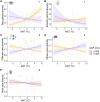Interactive effects of climate and land use on pollinator diversity differ among taxa and scales
- PMID: 35544641
- PMCID: PMC9075793
- DOI: 10.1126/sciadv.abm9359
Interactive effects of climate and land use on pollinator diversity differ among taxa and scales
Abstract
Changes in climate and land use are major threats to pollinating insects, an essential functional group. Here, we unravel the largely unknown interactive effects of both threats on seven pollinator taxa using a multiscale space-for-time approach across large climate and land-use gradients in a temperate region. Pollinator community composition, regional gamma diversity, and community dissimilarity (beta diversity) of pollinator taxa were shaped by climate-land-use interactions, while local alpha diversity was solely explained by their additive effects. Pollinator diversity increased with reduced land-use intensity (forest < grassland < arable land < urban) and high flowering-plant diversity at different spatial scales, and higher temperatures homogenized pollinator communities across regions. Our study reveals declines in pollinator diversity with land-use intensity at multiple spatial scales and regional community homogenization in warmer and drier climates. Management options at several scales are highlighted to mitigate impacts of climate change on pollinators and their ecosystem services.
Figures






Similar articles
-
Pyrodiversity begets plant-pollinator community diversity.Glob Chang Biol. 2016 May;22(5):1794-808. doi: 10.1111/gcb.13236. Epub 2016 Feb 29. Glob Chang Biol. 2016. PMID: 26929389
-
Land-use type and intensity differentially filter traits in above- and below-ground arthropod communities.J Anim Ecol. 2017 May;86(3):511-520. doi: 10.1111/1365-2656.12641. Epub 2017 Feb 28. J Anim Ecol. 2017. PMID: 28118484
-
Key tropical crops at risk from pollinator loss due to climate change and land use.Sci Adv. 2023 Oct 13;9(41):eadh0756. doi: 10.1126/sciadv.adh0756. Epub 2023 Oct 12. Sci Adv. 2023. PMID: 37824611 Free PMC article.
-
The role of climate change in pollinator decline across the Northern Hemisphere is underestimated.Sci Total Environ. 2021 Jun 25;775:145788. doi: 10.1016/j.scitotenv.2021.145788. Epub 2021 Feb 12. Sci Total Environ. 2021. PMID: 33618305 Review.
-
Effects of global change on insect pollinators: multiple drivers lead to novel communities.Curr Opin Insect Sci. 2017 Oct;23:22-27. doi: 10.1016/j.cois.2017.06.009. Epub 2017 Jul 1. Curr Opin Insect Sci. 2017. PMID: 29129278 Review.
Cited by
-
Effects of land cover and protected areas on flying insect diversity.Conserv Biol. 2025 Aug;39(4):e14425. doi: 10.1111/cobi.14425. Epub 2024 Dec 4. Conserv Biol. 2025. PMID: 39628456 Free PMC article.
-
Different roles of concurring climate and regional land-use changes in past 40 years' insect trends.Nat Commun. 2022 Dec 12;13(1):7611. doi: 10.1038/s41467-022-35223-3. Nat Commun. 2022. PMID: 36509742 Free PMC article.
-
Important Crop Pollinators Respond Less Negatively to Anthropogenic Land Use Than Other Animals.Ecol Evol. 2024 Oct 30;14(11):e70486. doi: 10.1002/ece3.70486. eCollection 2024 Nov. Ecol Evol. 2024. PMID: 39493619 Free PMC article.
-
Linking climate warming and land conversion to species' range changes across Great Britain.Nat Commun. 2023 Oct 30;14(1):6759. doi: 10.1038/s41467-023-42475-0. Nat Commun. 2023. PMID: 37903781 Free PMC article.
-
Soundscapes and deep learning enable tracking biodiversity recovery in tropical forests.Nat Commun. 2023 Oct 17;14(1):6191. doi: 10.1038/s41467-023-41693-w. Nat Commun. 2023. PMID: 37848442 Free PMC article.
References
-
- Seibold S., Gossner M. M., Simons N. K., Blüthgen N., Müller J., Ambarlı D., Ammer C., Bauhus J., Fischer M., Habel J. C., Linsenmair K. E., Nauss T., Penone C., Prati D., Schall P., Schulze E.-D., Vogt J., Wöllauer S., Weisser W. W., Arthropod decline in grasslands and forests is associated with landscape-level drivers. Nature 574, 671–674 (2019). - PubMed
-
- van Klink R., Bowler D. E., Gongalsky K. B., Swengel A. B., Gentile A., Chase J. M., Meta-analysis reveals declines in terrestrial but increases in freshwater insect abundances. Science 368, 417–420 (2020). - PubMed
-
- Dainese M., Martin E. A., Aizen M. A., Albrecht M., Bartomeus I., Bommarco R., Carvalheiro L. G., Chaplin-Kramer R., Gagic V., Garibaldi L. A., Ghazoul J., Grab H., Jonsson M., Karp D. S., Kennedy C. M., Kleijn D., Kremen C., Landis D. A., Letourneau D. K., Marini L., Poveda K., Rader R., Smith H. G., Tscharntke T., Andersson G. K. S., Badenhausser I., Baensch S., Bezerra A. D. M., Caballero-Lopez B., Cavigliasso P., Classen A., Cusser S., Dudenhöffer J. H., Ekroos J., Fijen T., Franck P., Freitas B. M., Garratt M. P. D., Gratton C., Hipólito J., Holzschuh A., Hunt L., Iverson A. L., Jha S., Keasar T., Kim T. N., Kishinevsky M., Klatt B. K., Klein A.-M., Krewenka K. M., Krishnan S., Larsen A. E., Lavigne C., Liere H., Maas B., Mallinger R. E., Pachon E. M., Martínez-Salinas A., Meehan T. D., Mitchell M. G. E., Molina G. A. R., Nesper M., Nilsson L., O’Rourke M. E., Peters M. K., Ple M., De L. Ramos D., Rosenheim J. A., Rundlöf M., Rusch A., Sáez A., Scheper J., Schleuning M., Schmack J. M., Sciligo A. R., Seymour C., Stanley D. A., Stewart R., Stout J. C., Sutter L., Takada M. B., Taki H., Tamburini G., Tschumi M., Viana B. F., Westphal C., Willcox B. K., Wratten S. D., Yoshioka A., Zaragoza-Trello C., Zhang W., Zou Y., Steffan-Dewenter I., A global synthesis reveals biodiversity-mediated benefits for crop production. Sci. Adv. 5, eaax0121 (2019). - PMC - PubMed
-
- Ollerton J., Winfree R., Tarrant S., How many flowering plants are pollinated by animals? Oikos 120, 321–326 (2011).
MeSH terms
LinkOut - more resources
Full Text Sources

